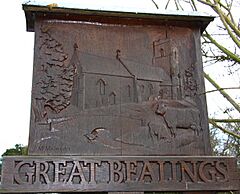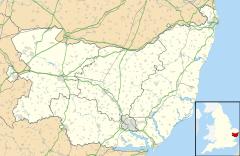Great Bealings facts for kids
Quick facts for kids Great Bealings |
|
|---|---|
 Great Bealings village sign |
|
| Area | 4.19 km2 (1.62 sq mi) |
| Population | 302 (2011) |
| • Density | 72/km2 (190/sq mi) |
| OS grid reference | TM231489 |
| District |
|
| Shire county | |
| Region | |
| Country | England |
| Sovereign state | United Kingdom |
| Post town | Woodbridge |
| Postcode district | IP13 |
| Dialling code | 01473 |
| Police | Suffolk |
| Fire | Suffolk |
| Ambulance | East of England |
| EU Parliament | East of England |
| UK Parliament |
|
Great Bealings is a small village in Suffolk, England. About 302 people live here in around 113 homes. The closest towns are Ipswich, which is about 6 miles (9.7 km) away, and Woodbridge, about 2.6 miles (4.2 km) away. Other nearby villages include Little Bealings, Playford, Culpho, Hasketon, and Grundisburgh.
Great Bealings doesn't have one clear village centre. People live in two main areas: Lower Street in the east and Boot Street/Grundisburgh Road in the west. The village church, St Mary's, is located right in the middle of these two areas.
The village shares a playing field with Little Bealings. It's behind their shared Village Hall. This field has a grassy area, a fenced court for different sports, and a playground for kids. There's even a special court for a game called boules. The field is named after John Ganzoni, Lord Belstead. He lived in the village for many years, and his charity helped pay for the project.
The River Lark flows through the middle of the village. The main road crosses the river using a humpback bridge.
Contents
A Look Back: Great Bealings History
In the Domesday Book, a famous survey from 1086, there's a mention of the Saxon Hall in Great Bealings. It was owned by a person named Halden, and a priest named Anund was there. This hall was by the church. Over time, different families owned it, like the de Peche, Clench, and Majors. In 1775, the Majors family took it down to use the materials to build Bealings House.
The village has always been a place for farming. There were many small farms. In a book from 1855 that listed businesses in Suffolk, Great Bealings had many different trades. These included a brickmaker, two shoemakers, a builder, a wheelwright (who made and repaired wheels), a blacksmith (who worked with metal), a gardener, a shopkeeper, and a miller (who ground grain). Of course, there were also many farmers.
What People Wrote About Great Bealings
In the late 1800s, two important books described Great Bealings.
In 1870–72, John Marius Wilson's Imperial Gazetteer of England and Wales wrote about the village. He said it was in the Woodbridge area, near the Deben river and the East Suffolk railway. He noted it was about 2.25 miles (3.6 km) west-southwest of Woodbridge. At that time, the village had 1,029 acres (4.16 km²) of land, and its property was worth £2,091. There were 338 people living in 88 houses. He also mentioned that Lord Henniker owned much of the land. The church was described as "good."
Later, in 1887, John Bartholomew wrote a shorter description in his Gazetteer of the British Isles. He simply said Great Bealings was a parish in East Suffolk, 2.5 miles (4 km) west of Woodbridge. He noted it had 1,036 acres (4.19 km²) and a population of 287 people.
Famous People from Great Bealings
Many interesting people have lived in or had connections to Great Bealings.
- The Seckford family owned land here since the time of Edward I. A famous member, Thomas Seckford, rebuilt Seckford Hall in 1530 as a country home. He was a close advisor to Elizabeth I, a very important queen. Thomas Seckford's parents are buried in Great Bealings Church.
- Admiral Pelham Aldrich was a naval officer who explored many parts of the world. He lived in Great Bealings and is buried in the churchyard. A mountain, Mount Aldrich, was named after him!
- Major Edward Moor served in the East India Company, a powerful trading company. He was wounded three times in battle. He was also a Fellow of the Royal Society, which is a group of top scientists. Moor wrote books about Indian mythology. He even wrote a mystery story called Bealings Bells in 1841, which was about a house that seemed to have haunted bell-pulls. He built a small pyramid near Bealings House, which included old Indian statues he found in Bombay. His son-in-law, William Page Wood, 1st Baron Hatherley, a famous lawyer and politician, is also buried in the churchyard.
- General Sir Richard Thomas Farren was a British Army officer. He lived in Bealings House and was buried in the churchyard in 1910 when he was 92 years old. There is a special memorial to him inside the church.
- Winifred Beech, an author, was born in Great Bealings rectory in 1888. Her father, Howard Beech, was the Rector (the main priest) of the village church.
- John Ganzoni, 2nd Baron Belstead was a Conservative politician. He was a very important leader in the House of Lords (part of the UK Parliament) from 1988 to 1990 under Prime Minister Margaret Thatcher. He is buried in the churchyard.
- Cynthia Cooke (1919-2016) was a military nurse. She became the Matron-in-Chief of the Queen Alexandra's Royal Naval Nursing Service, which is the nursing branch of the Royal Navy. She received high honors for her service, including being made a Commander of the Order of the British Empire in 1975.
Images for kids
Related pages
- Little Bealings
- Bealings railway station
- Seckford Hall








